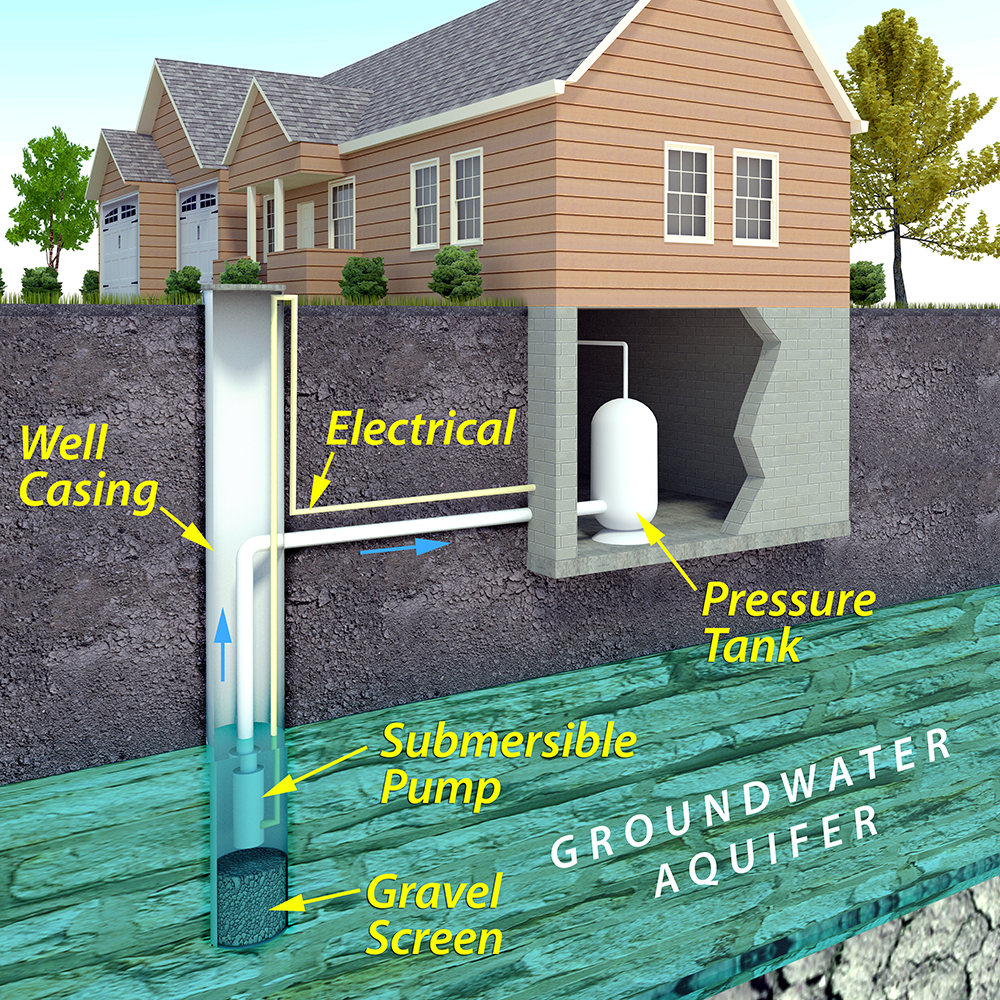
Fortunately, today’s well systems work a bit differently than in the past. Well owners no longer have to lower a bucket into a hole in the ground and transport buckets full of water to where they need it. Modern plumbing makes things much easier today, but did you ever stop to wonder just how a well works?
If you’re used to having city water, you might have questions about how the well works at your new rural home. Or, perhaps your current home has a well, but you haven’t put too much thought into it since the water seems fine. However, is the water safe? Is there anything you need to do to maintain it? What can go wrong?
The fact is, there are concerns with well water that need to be understood. Knowing more about how a well works can give you a better understanding of your options and responsibilities. Ultimately, with well water, the quality of the water is managed by you.
Well water and your home
Well water is untreated groundwater stored in aquifers (underground layers of porous rock). Wells get drilled as far down as 1,000 feet into the rock to access the water. Pipe casing gets installed into the hole, and a concrete or clay sealant surrounds it to protect against contaminants. Water travels through this casing via a well pump. The well system gets capped off above ground. The water then enters your home from a pipe connected between the casing and a pressure tank (generally located in your home’s basement). From there, it gets distributed to faucets throughout your home.
Some people are under the impression that well water is “pure” since it comes from within the earth. However, it’s rainwater which has moved through the air, across the ground, and through the soil. By the time well water gets into your home, there’s likely more to it than just water. Those elements can affect your pipes, clothes, food, skin, and your health.
What’s in well water?
Well water is more likely to be hard water, meaning that it contains minerals like calcium and magnesium. Water containing minerals can be a good thing. Still, too many minerals can create build-up in pipes and heating systems, leading to costly repairs. Hard water also performs poorly with soaps and detergents, leaving spots on dishes, shower doors, and generally not cleaning things as well as soft water.
Water coming from your well is also more likely to encounter other contaminants. Depending on where you live, iron, sulfur gas, arsenic, nitrates, tannins, and various other items found in nature could be present. Some parts of the country do not have iron issues. In contrast, other areas might have entire neighborhoods with whole-home iron filters to prevent rust stains from forming on everything their water touches.
Homeowners with well water should have their water tested by a licensed professional at least once per year. Many contaminants cannot be seen or smelled, so you’ll want to make sure there isn’t anything present that might affect your family’s health.
Keeping contamination away
Besides the environmental factors that could be in your well water, you’ll also want to make sure the well casing is in good condition. This chamber holds your well pump and should stay wholly enclosed to help keep your water source clean. Cracks in your well cover or casing walls will leave your well exposed to dirt, insects, or rodents that can cause e.coli bacteria to grow inside your well.
Having this bacteria in your water isn’t so bad if you’re using it for your laundry or taking a shower. Still, it can become an issue when it comes to the water you drink and use for cooking. While not harmful to your health, consuming e.coli bacteria can give you a stomach ache and diarrhea. The only way to know for sure if you have bacteria contamination in your well is to have it tested. If the test results come back positive, don’t worry, there is a solution! A local water expert can “shock” the well using chlorine, but make sure to inspect the well itself to ensure that it will adequately seal again once finished. Otherwise it will just get contaminated again.
Here’s a checklist for keeping your well in good working order:
- Always use licensed or certified service technicians for any maintenance on your well
- Conduct testing annually, or when a change in taste, appearance, or odor are detected
- Keep hazardous chemicals away from the well
- Occasionally check the well cover cap to make sure it’s secure and in good shape
- Make sure the cap is at least 6” above ground
- Keep the well cap area free of debris and take care when mowing or moving around it
There are a variety of products that can give you peace of mind that you’re drinking and washing with quality water. For example, a water softener will help filter out excess minerals which can make your hair limp, skin itchy and cleaning difficult. A filtration system will tackle elements like chlorine, iron, manganese, and more, which will eliminate unwanted tastes and stains. And, you could consider a reverse osmosis system to eliminate harmful contaminants in your drinking water.
Remember, a well system transports water from the ground to your home; it doesn’t do anything to treat or sanitize the water. With water testing, an accurate diagnosis and recommendation, you can overcome even the most challenging well water.
All Water-Right dealers are equipped to help you with your problem water needs.

